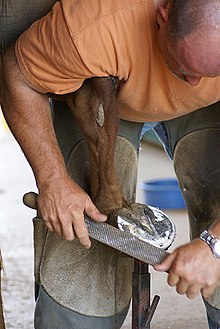

A rasp is a coarse form of file used for coarsely shaping wood or other material. Typically a hand tool, it consists of a generally tapered rectangular, round, or half-round sectioned bar of case hardened steel with distinct, individually cut teeth. A narrow, pointed tang is common at one end, to which a handle may be fitted.[1]
Use[edit]
Rasps come in a variety of shapes—rectangular, round, and half-round—and vary in coarseness from finest, "cabinet", to most aggressive, "wood".[2] Farriers, for example, commonly use rasps to remove excess wall from a horse's hoof. They are also used in woodworking for rapidly removing material and are easier to control than a drawknife. The rough surfaces they leave may be smoothed with finer tools, such as single- or double-cut files. Rasps are used in shaping alabaster. Saws and chisels are used to rough out alabaster work.
See also[edit]
References[edit]
- ^ Lye, P. F. (1993), Metalwork theory, Book 1, Nelson Thornes, pp. 12–13, ISBN 978-0-17-444313-1.
- ^ Paul N. Hasluck (February 2011). The Handyman's Guide: Essential Woodworking Tools and Techniques. Skyhorse Publishing Inc. p. 119. ISBN 978-1-60239-173-4.
Well, that’s interesting to know that Psilotum nudum are known as whisk ferns. Psilotum nudum is the commoner species of the two. While the P. flaccidum is a rare species and is found in the tropical islands. Both the species are usually epiphytic in habit and grow upon tree ferns. These species may also be terrestrial and grow in humus or in the crevices of the rocks.
View the detailed Guide of Psilotum nudum: Detailed Study Of Psilotum Nudum (Whisk Fern), Classification, Anatomy, Reproduction